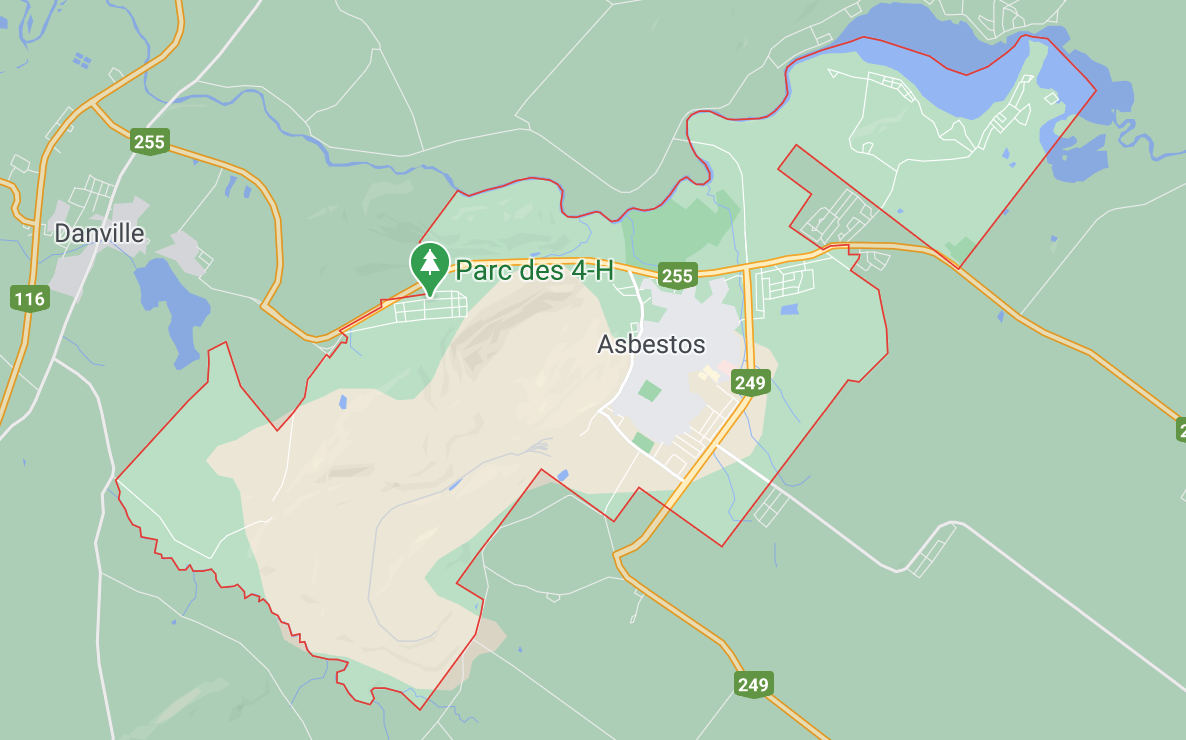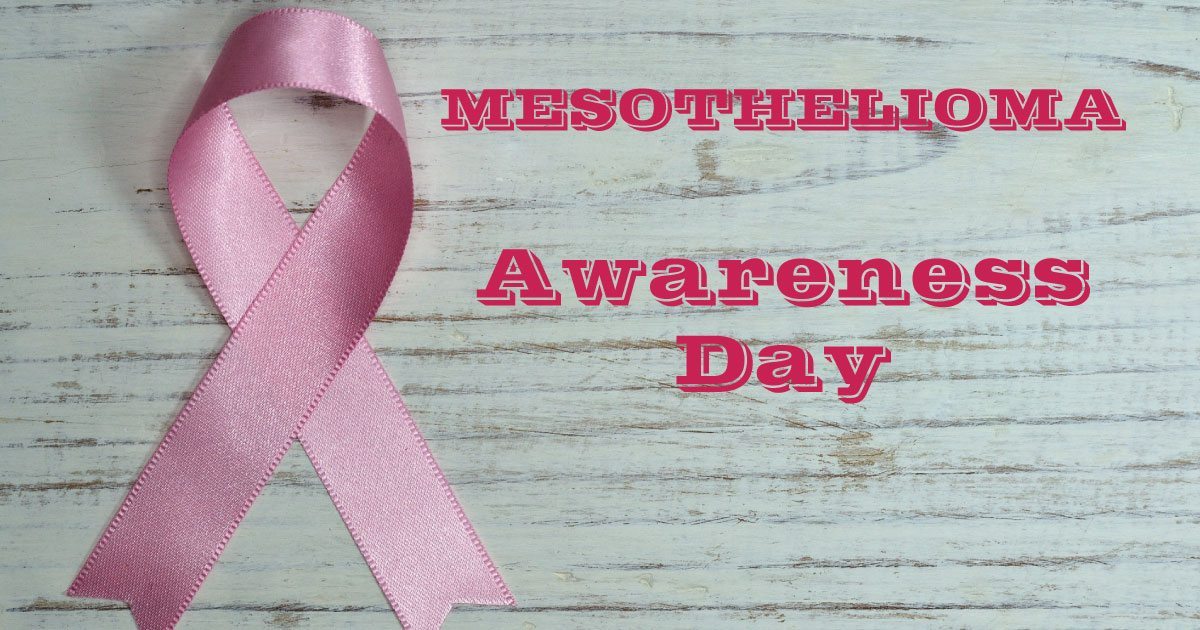Category: International News

Residents of the Town of Asbestos in Canada Consider New Name
With the internet, social media, and many other modern forms of communication, everyone’s “brand” and naming has taken on increased importance. It is not unusual for a company to rebrand itself with a different feature that they want people to associate with their business. In this case, there is a town’s name associated with disease and death.
The news from Asbestos, Canada a year ago was that the town leaders wanted to change the name because of the negative connotations that the word asbestos holds. Asbestos, Canada is the home to the Jeffrey Mine and is a small town 80 miles east of Montreal. The approximate population is around 7,000 people.
For many years the Jeffrey Mine, which was named after W.H. Jeffrey, who bankrolled the town’s asbestos mine, was the leading producer of asbestos in the world. The mine made Canada one of the world’s leaders in asbestos exportation. It was last owned by the Johns Manville Corporation.
A vote was scheduled to be taken by the townspeople in October on what to change the name to. The four choices that were to be voted on were:
- Apalone – an indigenous species of turtles.
- Jeffrey – W.H. Jeffrey bankrolled the town’s Jeffrey Asbestos Mine.
- Phoenix – the mythological bird of rebirth.
- Trois-Lacs – a local lake and the name of a municipality that merged with Asbestos in 1999.
This week the leaders of Asbestos, Canada decided to “pause” the re-naming as there is a lot of dissension among the town people on the changing of the name.
Asbestos causes cancer. This was declared by the World Health Organization over 30 years ago. It is a fact no amount of rebranding can hide. Asbestos continues to kill people.
Approximately 100,000 people die globally each year from asbestos related diseases. Asbestos can cause lung cancer, malignant mesothelioma, and asbestosis. It is estimated that at least 80-85 percent of cases of malignant mesothelioma can be traced to exposure to asbestos. Changing the name of the town will not change the history of what asbestos has and continues to do to the health of the world.
Asbestos, Canada will always be associated with the Jeffrey Mine and asbestos manufacturing. The legacy of the damage that asbestos has done to peoples’ lives and contributed to their premature deaths cannot be rebranded.
We wish the people of Asbestos the best as they search for a new name and a healthy future that does not highlight their history in asbestos production.

September 26 Is National Mesothelioma Awareness Day
Each year, the mesothelioma community across the nation comes together for Mesothelioma Awareness Day, a time devoted to raising public awareness about the life-threatening cancer and its cause ─ exposure to asbestos.
Patients, family members, friends, advocates and health care professionals are encouraged to share their personal stories, struggles and inspiration in order to bring attention to the disease and further the search for a cure.
When Is Mesothelioma Awareness Day?
Mesothelioma Awareness Day is held on Sept. 26. In 2018, September 26 falls on a Wednesday.
In an effort to expand the impact of Mesothelioma Awareness Day, advocates have encouraged patients, caregivers, family and friends to participate in Mesothelioma Awareness Week surrounding Sept. 26, as well as Mesothelioma Awareness Month throughout September.
Mesothelioma Awareness Day History
In 2004, the Mesothelioma Applied Research Foundation organized the original Mesothelioma Awareness Day. Since then, the national nonprofit organization has continued to build momentum by promoting the day as a time for all those touched by the cancer to talk about its impact.
In 2010, Congress joined the effort by establishing Mesothelioma Awareness Day as a time for the nation to recognize that thousands of Americans are diagnosed with the preventable cancer each year. In fact, despite its designation as a known carcinogen, asbestos is still not banned in the United States, and Americans are still at risk of exposure.
The Importance of Awareness Day
The National Mesothelioma Awareness Day resolution asks that the President of the United States issue a proclamation calling for all Americans, federal agencies and departments, state governments, local municipalities, organizations, and news media to properly observe the day.
The Congressional Declaration outlines these key facts about malignant mesothelioma as reasons for promoting awareness of the deadly asbestos cancer:
- Although workers who were exposed to asbestos on a daily basis over a long period of time are most at risk of developing mesothelioma, even short-term exposures can cause the disease. In fact, exposure to asbestos for as little as one month can result in mesothelioma 20 to 50 years later.
- Asbestos materials were used in the construction of virtually all office buildings, public schools, and homes built before 1975. Still today, asbestos is used in more than 3,000 products being sold in the United States.
- The National Institutes of Health reported to Congress in 2006 that mesothelioma is a difficult disease to detect, diagnose and treat.
- For decades, the need to develop treatments for mesothelioma was overlooked. Still today, even the best mesothelioma treatments usually have a very limited effect, with the expected survival time of 8 to 14 months.
- It is believed that many of the firefighters, rescue workers and police officers from Ground Zero on September 11, 2001, may be at increased risk of developing mesothelioma in the future due to asbestos exposure at the site.
Every year, about 3,000 people in the United States are diagnosed with mesothelioma. Around the world, an estimated 38,400 people die each year from the devastating asbestos illness.
Unfortunately, those numbers are not dwindling. Mesothelioma statistics indicate an increase in deaths in recent years, with an 8 percent increase in fatalities in the United States for the 10-year period that ended in 2015.
These facts point to the importance of Mesothelioma Awareness Day in educating people about the dangers of asbestos and promoting the need for continued research into more effective treatments.
Paint the World in Mesothelioma Awareness
Just as breast cancer is associated with the color pink, support for mesothelioma awareness is often represented by a colored ribbon. The mesothelioma awareness color is blue or pearl.
Friends and family members of patients typically don pearl or blue ribbons in a show of solidarity with their loved ones who are fighting the life-threatening disease.
The Mesothelioma Applied Research Foundation also encourages people to participate in its “Paint the World in Mesothelioma Blue” campaign to raise awareness by wearing blue and sharing photos of themselves on social media.
How You Can Show Support on Mesothelioma Awareness Day
Since its founding, the nonprofit Mesothelioma Applied Research Foundation has advocated for patients and families while coordinating fundraising events to support research efforts related to the disease. This national organization is committed to finding a cure for mesothelioma and ending the suffering it causes.
One way to show your support on Mesothelioma Awareness Day is to make a donation to the Meso Foundation. Your contribution will help fund the organization’s efforts to support mesothelioma patients and the ongoing search for a cure.
You may also choose to show your support by wearing (and asking others to wear):
- Mesothelioma awareness ribbons
- Mesothelioma awareness pins
- Mesothelioma awareness bracelets
- Mesothelioma awareness wristbands
- Mesothelioma awareness shirts
At Mesothelioma Help Cancer Organization, we aim to raise awareness year-round, in particular through our Mesothelioma Awareness Scholarship Contest. As part of this contest, students submit essays sharing their own experiences with mesothelioma as well as their efforts for raising awareness of the dangers of asbestos. We encourage the students to share their essays on social media to help spread the word.
Quick Facts to Share on Mesothelioma Awareness Day
- Asbestos is the only known cause of mesothelioma. It has also been shown to cause lung cancer.
- Asbestos was commonly used on Navy ships and in shipyards. Veterans account for approximately one-third of mesothelioma diagnoses.
- Industrial workers and construction workers are at an increased risk of developing mesothelioma and other asbestos diseases.
- Family members of those who worked with asbestos may have faced secondhand exposure through fibers brought home on clothing or skin.
- Although the U.S. government has safety regulations in place, it has not banned the use of asbestos.
- There is no safe level of asbestos exposure.
- Renovation projects on older homes and demolition of older buildings can put people at risk of asbestos exposure.
- Never try to remove asbestos materials on your own. Contact an asbestos abatement professional.
- Companies that made asbestos products understood the health risks but failed to warn the public.
- Mesothelioma patients and families may be entitled to compensation for damages due to asbestos exposure.
- Even if an asbestos company has gone out of business, funds may be available in a bankruptcy trust for mesothelioma victims.
Sources:
- Mesothelioma Applied Research Foundation
https://www.curemeso.org/get-involved/get-involved-events/mesothelioma-awareness-day - Make a Donation
https://www.curemeso.org/donate

Study Shows That Asbestos Risks Remain Decades After Industry Departs
An Italian study published back in May found that malignant mesothelioma cases tend to be concentrated around industrial facilities that use asbestos. A new Italian study finds that mesothelioma incidence near industrial areas remains high long after an asbestos-using industry ceases operations.
Asbestos is the only known cause of mesothelioma, an incurable cancer affecting the membranous lining of the lungs and abdomen. Most cases of mesothelioma are related to occupational asbestos exposure. Cement factories, shipyards, automotive plants, food processing facilities, power plants, and steel plants are among the major sources of occupational asbestos exposure.
Not all asbestos exposure, however, is directly attributable to a person’s work activities. People can also be environmentally exposed to asbestos in areas where asbestos industries operate.
One such area is Casale Monferrato in Northwest Italy, the former home of the Eternit asbestos-cement plant, which closed in 1986. An Italian court in 2012 convicted the plant’s owners of causing the asbestos-related deaths of more than 3,000 people. While many of those people worked at the Eternit plant, others merely lived near the plant.
Casale Montferro is the subject of a study published recently in Occupational & Environmental Medicine. The study authors identified 200 cases of pleural mesothelioma diagnosed in Casale Montferro residents between 2001 and 2006 in an effort to quantify the association between pleural mesothelioma and asbestos exposure.
They discovered that the odds ratio (OR, a measure of association between an exposure and an outcome) of an asbestos-exposed individual developing mesothelioma ranged from 4.4 to 62.1, with increased exposure over time resulting in a higher OR. Subjects never occupationally exposed to asbestos had a mesothelioma OR of 3.8 to 23.3, while an OR of around 2 was observed for people living in homes near buildings with large asbestos cement parts.
The findings draw attention to the fact that asbestos health risks linger in the environment long after asbestos industries vacate. In addition, they serve as a reminder that asbestos disease can occur in people who never directly handled asbestos on the job.
“Risk of [pleural malignant mesothelioma] increased with cumulative asbestos exposure and also in analyses limited to subjects non-occupationally exposed. Our results also provide indication of risk associated with common sources of environmental exposure and are highly relevant for the evaluation of residual risk after the cessation of asbestos industrial use,” write the study authors.
The Italian study has implications for America and other countries with a history of industrial asbestos use. U.S. asbestos use peaked in the mid-70s, but asbestos diseases, which have a latency period of 10-40 years or more, continue to kill an estimated 12,000-15,000 Americans.
But the United States, unlike Italy, has not banned asbestos. While both countries deal with the residual presence of asbestos-containing materials from a bygone industrial era, the United States is unique among industrialized nation for its ongoing importation and use of asbestos.
Anyone interested in taking part in the fight against asbestos should visit the EWG Action Fund website.

Italian Study: Mesothelioma Cases Concentrated Near Asbestos-Using Industries
Italian researchers looked at the geographic distribution of malignant mesothelioma cases and found that they tend to be clustered around cement manufacturing, shipbuilding, and other industrial facilities.
A team lead by Marisa Corfiata analyzed 15,322 incident cases of malignant mesothelioma from the period 1993 to 2008 recorded by the Italian national mesothelioma registry. Subjects were interviewed and asbestos exposure—the only known cause of mesothelioma—was defined for 11,852 of 15,322 cases. Cases were then then mapped and geographic clusters identified for the Northwest, Northeast, Centre, and South & Islands regions of Italy. Finally, case clusters were identified according to one of three asbestos exposure modalities: environmental, familial, and occupational.
According to the researchers, the main sources of mesotheliomas are cement manufacturing plants and shipyards, while several case clusters were also found in the vicinity of asbestos textile facilities.
“The largest [malignant mesothelioma] clusters, per number of cases or municipalities included were found, indeed, where the biggest asbestos cement plants or shipyard facilities were located,” writes Corfiata. “Overall, it should be noted that an asbestos cement industry, an asbestos textile industry or a harbor industrial area inclusive of shipyards partially contribute to exposure of MM cases in about 75% of the clusters identified.”
Diving deeper into the numbers, the researchers note that the high number of mesothelioma cases among women in the largest asbestos-cement industry clusters may be attributable to familial exposure, or so-called “take home” exposure, which occurs when one family member brings home asbestos fibers on their body or clothing and exposes other family members. For the shipyard clusters, mesothelioma is mainly associated with naval construction and/or repair activities.
The researchers also note a number of other industrial asbestos exposure sources, including steel manufacturing plants, metal product manufacturing, oil refineries, chemical facilities, power plants, railway carriage construction and maintenance, the automotive industry, glass industry, and food processing. These are many of the same industries that have historically in the United States produced occupational asbestos exposure.
But unlike the United States, Italy has enacted a national asbestos ban. The study points out that Italian asbestos consumption peaked later in Italy than in the U.S., and, given the 35-40 year latency period of mesothelioma, “a high number of cases is still expected in Italy in the next few decades.”
Mesothelioma incidence is thought to have already peaked in the United States, but as long as the use of asbestos products remains legal in this country, the carcinogenic mineral fiber continues to pose a threat to public health. Each year in the U.S. approximately 3,000 people are diagnosed with mesothelioma, while 10,000 total death are attributed to asbestos.
You can read the full text of the Italian report “Epidemiological patterns of asbestos exposure and spatial clusters of incident cases of malignant mesothelioma from the Italian national registry” at BMC Cancer.

Global Mesothelioma Rates Increasing in Many Countries, Italian Researchers Say
Mesothelioma incidence is on the rise in several nations, data show, but a lack of data for some of the world’s most populous countries, among other factors, obscures the true risk of asbestos exposure worldwide.
That’s the conclusion reached by Claudio Bianchi and Tommaso Bianchi of the Center for the Study of Environmental Cancer in Monfalcone, Italy in an article published in the Indian Journal of Occupational & Environmental Medicine. It is based on their analysis of data on mesothelioma incidence in Europe and Oceania as well as parts of Asia, the Middle East, and South America.
https://www.ncbi.nlm.nih.gov/pmc/articles/PMC2847331/
“The most recent data available on mesothelioma epidemiology show that in many counties the incidence of the tumor does not present signs of attenuation,” write the researchers.
Countries with high mesothelioma incidence rates include the United Kingdom, The Netherlands, Malta, Belgium, Australia, and New Zealand—countries that, with the exception of New Zealand, have banned asbestos.
Intermediate mesothelioma incidence rates were found in several European countries and the United States, where diagnoses peaked in 2005 at 3,284 but have since declined somewhat. Low incidence and mortality rates were reported for other European countries and parts of Asia, including Japan.
But as the researchers caution, a lack of data for a number of populous countries where asbestos is still not banned (e.g. Russia, China, Brazil, Indonesia, and India) calls the data’s reliability into question.
“On the basis of global asbestos consumption in the last decades, one may predict that a further mesothelioma wave will involve large geographic areas,” write the Italians. “These are exactly the same for which data are not at present available.”
The reliability of the data is also reduced by the difficulty of diagnosing mesothelioma and huge variations in incidence from one area of a country to another, something that the researchers say makes incidence rates at a national level misleading. Italian data from 1988-1997 show, for example, pleural cancer mortality rates that differ by 40 fold from one Province to another. According to the study authors, mesothelioma cases are typically clustered around asbestos-intensive industries such as factories and shipyards.
In Japan, however, a country heavily involved in shipbuilding throughout the 20th century, low mesothelioma incidence does not square with asbestos use history. The Bianchis theorize that this underestimation is attributable to “inadequate registration of the death causes” previously detected in Japan. Other countries with large 20th century shipbuilding industries but low mesothelioma incidences are Poland and Spain.
A final statistical factor to consider is mesothelioma incidence among age classes. The Bianchis cite a 2013 report on mesothelioma in the United States that found an annual mesothelioma incidence rate that increased with age. In the period 2003-2008 the incidence rate was 8.34 per 1,000 for the age class 65-74, 17.07 for the class 75-84, and 17.62 for the class 85+.
This reflects the long latency period of mesothelioma, which does not develop for 15-60 years following initial exposure to asbestos. It also reinforces the ideas that the phasing out of asbestos use may still be followed by a decades-long upward trend in asbestos disease incidence.
The full article, “Global mesothelioma epidemic: Trends and features,” can be read on the Indian Journal of Occupational & Environmental Medicine website.
https://www.fightmesofoundation.com/
Free Mesothelioma Patient & Treatment Guide
We’d like to offer you our in-depth guide, “A Patient’s Guide to Mesothelioma,” absolutely free of charge.
It contains a wealth of information and resources to help you better understand the condition, choose (and afford) appropriate treatment, and exercise your legal right to compensation.
Download Now